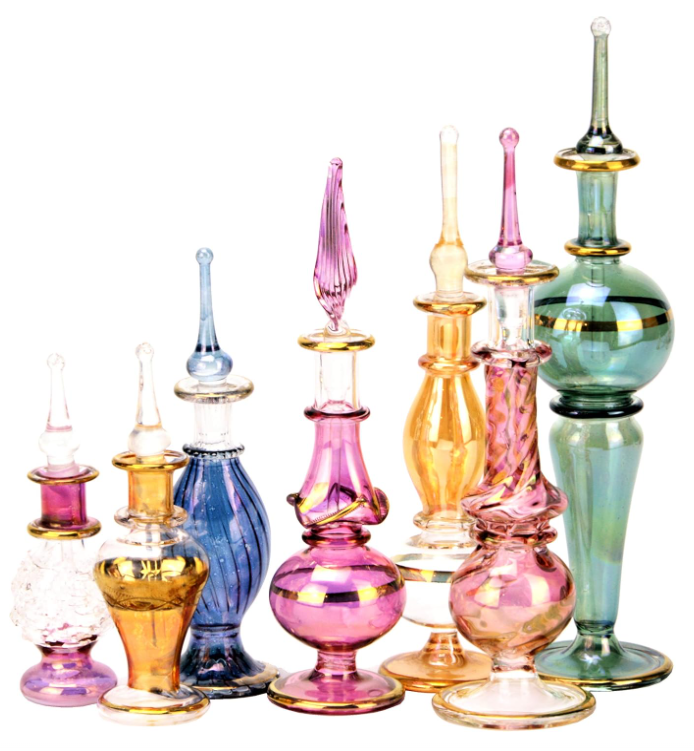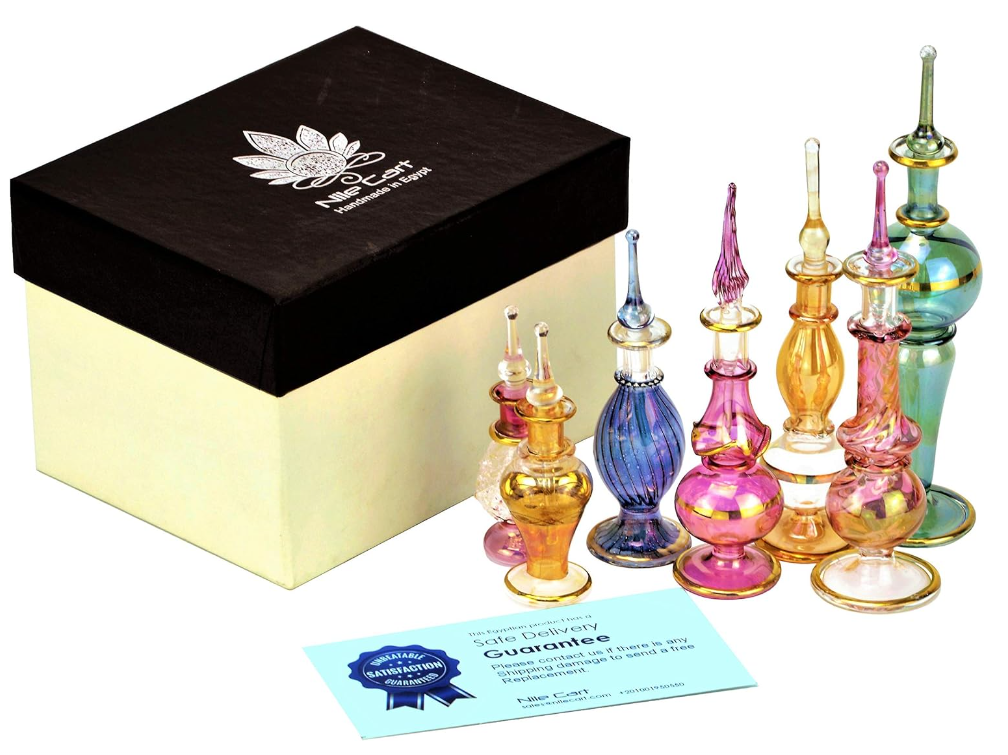The perfume bottle has more than just containers for fragrance; they are works of art that embody luxury, beauty, and craftsmanship. Since ancient times, The perfume bottle has evolved from simple vessels to ornate objects of desire, with some even becoming prized collector’s items. In this blog, we will deeply dive into the history of perfume bottles, their design elements, and their role in the world of fragrance. Whether you are a perfume enthusiast, a collector, or simply curious about the story behind these delicate containers, this article will explore the perfume bottle in-depth.

- The Origins of the Perfume Bottle: A Historical Journey
Perfume has been an integral part of human culture for thousands of years, and its containers have evolved alongside it. The earliest perfume bottles were simple in form and designed primarily for practical purposes. However, as civilizations developed, so did the art of bottling perfume.
Ancient Egypt: The Birthplace of Perfume and Its Containers
The ancient Egyptians were among the first to develop perfume, using it in religious ceremonies, personal use, and embalming. The perfume was often associated with the gods and royalty, making its containers objects of reverence. Early Egyptian perfume bottles were made from materials. One of them is alabaster, a soft stone that could be carved into intricate designs. These bottles were often small, as perfumes were precious and used sparingly.
Egyptians believed that the scent of perfume connected them to the divine. Thus, the design of their perfume bottles was often elaborate and symbolic. For example, some bottles were shaped like animals or gods, reflecting the spiritual importance of fragrance in their lives.
Ancient Greece and Rome: Elegance and Innovation
Greek and Roman perfume bottles were typically made from glass, pottery, or metal, and they often featured intricate designs and motifs.
The Greeks were known for their skill in pottery, and they created perfume bottles known as lekythoi—narrow-necked vessels used to store oil and perfume. These bottles were often decorated with mythology scenes, making them functional and decorative.
The Romans, who inherited much of their perfume culture from the Greeks, took bottle design to new heights. Roman glassmakers developed innovative techniques for creating glass bottles, including using moulds to create intricate shapes. Some Roman perfume bottle were shaped like fruits, animals, or even miniature statues, showcasing the artistry and creativity of the time.
The Middle Ages: A Shift in Perfume Bottle Design and Use
With the fall of the Roman Empire, perfume use declined in Europe during the early Middle Ages. Islamic glassmakers, particularly in places like Syria and Egypt, were renowned for their skill in creating beautiful glass perfume bottles.
In Europe, perfume began to rise again during the Crusades, as returning soldiers returned fragrances and perfume-making techniques from the East. By the late Middle Ages, perfume had become popular among the European elite, and The perfume bottle became more ornate, often made from materials like crystal, silver, and gold. These bottles were sometimes engraved or encrusted with jewels, symbolizing wealth and status.
- The Renaissance of Perfume Bottle: Artistic Flourishes and Symbolism
The Renaissance was a period of cultural rebirth in Europe, and perfume experienced a resurgence in popularity. The Perfume bottle from this era reflected the artistic and intellectual flourishing of the time with practical and symbolic designs.
The Influence of Italian Glassmaking
One of the most significant developments in perfume bottle design during the Renaissance came from the Italian island of Murano, where glassmakers perfected the art of glassblowing. Murano glass became synonymous with luxury; perfume bottles made from this material were highly prized. These bottles were often intricately decorated with gold leaf, enamel, and millefiori (a technique that created colourful patterns within the glass).
The Venetians, who dominated the glass trade, produced perfume bottles that were not only beautiful but also functional. Many of these bottles were designed with stoppers that helped preserve the fragrance, a critical innovation at a time when perfumes were made from natural ingredients that could spoil.
Symbolism in Perfume Bottle Design
During the Renaissance, perfume bottles were often imbued with symbolic meaning. For example, bottles shaped like hearts, roses, or doves were given as tokens of love and affection. Bottles shaped like religious symbols, such as crosses or angels, held holy oils or scented water for religious ceremonies.


Perfume bottles were also used as status symbols. Nobility and royalty would commission custom-designed bottles from the finest artisans, often made from precious materials like gold, silver, and gemstones. These bottles were displayed prominently in the homes of the wealthy, signalling their taste and sophistication.
- The Golden Age of Perfume Bottles: 18th and 19th Centuries
The 18th and 19th centuries marked a golden age for perfume bottles, with advances in glassmaking and a growing demand for luxury goods. As perfume became more accessible to the middle class, perfume bottle design became more varied and ornate.
The Rococo Influence
The 18th century was dominated by the Rococo style, which was characterized by its elaborate, asymmetrical designs and use of soft, pastel colours. Perfume bottles from this era often featured delicate floral patterns, swirling lines, and ornate detailing. Many bottles were made from porcelain and decorated with gold accents.
Rococo perfume bottles were often small and dainty, designed to be carried in a pocket or worn as jewellery. Some bottles were even designed to be worn as necklaces, with a chain attached to the stopper. These “scent lockets” allowed wearers to carry their favourite fragrance wherever they went.
The Rise of Crystal Perfume Bottle
The discovery of lead crystal revolutionized the perfume bottle industry in the 19th century. With its clarity and ability to be cut into intricate patterns, the crystal became the material of choice for luxury perfume bottles. French and English glassmakers, such as Baccarat and Lalique, became renowned for their crystal perfume bottles, often adorned with intricate engravings or hand-painted designs.
Crystal perfume bottles were prized for their beauty and craftsmanship, and they became a status symbol among the wealthy. Many of these bottles were designed to be refillable, allowing users to continue using the same bottle for years.
- Perfume Bottles in the 20th Century: Innovation and Modernity
The 20th century brought significant changes to the perfume industry, with the rise of mass production, new materials, and a shift in design aesthetics. Perfume bottles became more standardized, but there was still room for innovation and artistic expression.
Art Nouveau and Art Deco: The Intersection of Art and Perfume
At the turn of the 20th century, the Art Nouveau movement brought a new level of artistic creativity to perfume bottle design. With its emphasis on natural forms and flowing lines, Art Nouveau influenced the design of many perfume bottles. The French glassmaker René Lalique was one of the most prominent figures in this movement, creating both functional and beautiful bottles. Lalique’s perfume bottles often featured intricate floral motifs, animal designs, and frosted glass, making them highly sought after by collectors.
In the 1920s and 1930s, the Art Deco movement took over, emphasizing geometric shapes, bold lines, and modern materials. Art Deco perfume bottles were often made from glass, metal, and Bakelite (an early form of plastic), reflecting the modernist spirit of the time. Some of the most iconic perfume bottles from this era, such as the bottle for Chanel No. 5, were simple yet elegant, embodying the sleek, minimalist aesthetic of Art Deco.
The Impact of Mass Production
Mass production became the norm as the perfume industry grew in the 20th century. This made perfume more affordable and accessible, but it also meant that perfume bottles became more standardized. However, artistry and innovation remained. Many perfume brands continued to collaborate with renowned designers and artists to create unique and memorable bottles.
One of the most iconic examples is the collaboration between Salvador Dalí and the perfume house Elsa Schiaparelli. Dalí, known for his surrealist art, designed a series of perfume bottles inspired by his artwork, including bottles shaped like lips and noses. These bottles became collector’s items, blurring the line between perfume and art.
In the world of fragrance, the perfume bottle is more than just a container; it is a crucial element of the brand’s identity and marketing strategy. A well-designed perfume bottle can evoke emotions, create a sense of luxury, and communicate the essence of the fragrance inside.
Packaging as an Extension of the Fragrance
When designing a perfume bottle, brands consider the overall concept of the fragrance and how the bottle can complement and enhance that concept. For example, a perfume with floral notes might be housed in a bottle shaped like a flower or adorned with floral motifs. In contrast, a perfume with a fresh, aquatic scent might come in a bottle that resembles a drop of water.
A sleek, minimalist bottle might convey a sense of modernity and sophistication. In contrast, an ornate, vintage-inspired bottle might evoke nostalgia and romance. Perfume bottles are often designed to appeal to the fragrance’s target demographic, whether that be young, trendy consumers or mature, luxury-seeking individuals.
The Iconic Bottle: A Key to Success
Some perfume bottles have become so iconic that they are instantly recognizable, even without the brand name. One of the most famous examples is the bottle for Chanel No. 5, designed by Coco Chanel in 1921. With its clean lines and minimalist label, the simple, rectangular bottle has become a symbol of timeless elegance and luxury.
Another iconic perfume bottle is that of Jean Paul Gaultier’s “Classique,” which is shaped like a woman’s torso. The bottle’s sensual curves and corset-inspired design perfectly capture the fragrance’s bold, provocative nature.
The bottle’s design is as important as the scent for many consumers. An eye-catching bottle can be a conversation piece, a decorative item, or a status symbol. In this way, the perfume bottle becomes a key part of the overall sensory experience of the fragrance.
- Perfume Bottle Collecting: A Passion for Beauty and History
For some, perfume bottles are more than just containers for fragrance; they are objects of beauty and history that are worthy of collection. Perfume bottle collecting has become a popular hobby, with collectors seeking out rare and vintage bottles from different eras and brands.
The Allure of Vintage Perfume Bottle
Collectors highly prize vintage perfume bottles, particularly those from the early 20th century. Some of the most valuable vintage perfume bottles come from luxury brands like Baccarat, Lalique, and Guerlain.
Collectors are drawn to vintage perfume bottles for their beauty and the stories they tell. Each bottle represents a specific moment in time, reflecting its era’s design trends, materials, and craftsmanship. For example, a perfume bottle from the 1920s might feature Art Deco elements. In comparison, a bottle from the 1950s might have a more streamlined, modernist design.
Perfume Bottle Auctions and Museums
Perfume bottle collecting has become such a popular hobby that there are now auctions and museums dedicated to these beautiful objects. Auction houses like Christie’s and Sotheby’s regularly hold perfume bottle auctions, where rare and valuable bottles can fetch thousands of dollars.
In addition, museums worldwide showcase perfume bottles and their history. The International Perfume Bottle Association (IPBA) hosts an annual convention where collectors can buy, sell, and trade perfume bottles, as well as attend seminars on perfume bottle history and design.
- The Future of Perfume Bottles: Sustainability and Innovation
As the world becomes more focused on sustainability, the perfume industry is also beginning to embrace eco-friendly practices. This shift impacts perfume bottle design, with brands exploring new materials and packaging solutions that are both environmentally friendly and aesthetically pleasing.
Sustainable Materials and Refillable Bottles
One key trend in perfume bottle design in the future is the use of sustainable materials. Many brands are now using recycled glass, biodegradable plastics, and other eco-friendly materials to create their perfume bottles. In addition, some brands are offering refillable bottles, allowing consumers to reuse the same bottle multiple times and reducing waste.
Refillable perfume bottles are not a new concept—many luxury brands have offered them for years—but the trend is gaining momentum as more consumers become conscious of their environmental impact. Some brands even offer refill stations in their stores, where customers can bring empty bottles to be refilled with their favourite fragrances.
Innovation in Bottle Design
While sustainability is a key focus for the future of perfume bottles, innovation in design is also playing a role. Advances in technology are allowing designers to create bottles that are more complex and intricate than ever before. For example, 3D printing creates unique, customizable perfume bottles. At the same time, new glassblowing techniques allow for more intricate and detailed designs.
In addition, some brands are experimenting with interactive packaging, such as bottles that change colour or emit light when touched.
Conclusion
The perfume bottle is much more than a functional container for fragrance—it is a symbol of beauty, craftsmanship, and luxury. From the simple glass vessels of ancient Egypt to the ornate crystal bottles of the 19th century, perfume bottles have evolved into works of art that capture the imagination and elevate the sensory experience of fragrance.
As we move into the future, perfume bottles will continue to play a crucial role in the world of fragrance, combining artistry and innovation with sustainability and eco-friendly practices. Whether you are a perfume enthusiast, a collector, or appreciate the beauty of a well-designed object, the perfume bottle will always hold a special place in the world of luxury and design.


